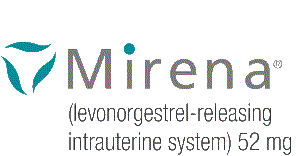About Mirena
An IUS (Intrauterine system) is a small, T-shaped device that’s placed in your uterus by your healthcare provider to help prevent pregnancy. Getting an IUS does not involve surgery, Your nurse or doctor will carry out some tests before you have Mirena fitted to make sure it is suitable for you to use. Once in place, it provides a slow release of hormone Levonorgestrel and can provide continuous contraception for up to 8 years.
You may experience pain, bleeding, or dizziness during and after placement. Your healthcare provider will examine you to see if Mirena needs to be removed or replaced.
Mirena is not the same as the copper coil. It is a hormonal coil, unlike the copper coil, which uses copper to prevent pregnancy. Mirena prevents pregnancy by releasing a small amount of hormone.
Your doctor or nurse can remove the Mirena at any time.
Unless you wish to get pregnant, the removal should be carried out during the first 7 days of your period. Otherwise it is important to use another form of contraception (e.g. condoms) in the 7 days leading up to the removal as intercourse during this week could lead to pregnancy after Mirena is removed.
Getting a Mirena fitted
Your nurse or doctor will carry out tests to check you are suitable to use Mirena, including a pelvic examination so that pregnancy and sexually transmitted diseases can be excluded and may also include other examinations such as a breast examination, if your doctor or nurse feels this is appropriate. Genital infections will need to be successfully treated before you can have Mirena fitted. If you have epilepsy, tell the doctor or nurse fitting the Mirena because, although rare, a seizure can occur during insertion. Some women might feel faint after the procedure. This is normal and your doctor or nurse will tell you to rest for a while.
Placing Mirena may feel similar to a smear test, so some women may feel uncomfortable, but you can ask your doctor or nurse about ways to minimise discomfort ahead of your appointment. You may want to bring a panty liner with you incase you experience any spotting or bleeding after placement.
You may experience pain, bleeding, or dizziness during and after placement. Discuss any symptoms with your healthcare provider.
If pain is a concern for you, ask your healthcare provider about taking over-the-counter pain medication before the procedure.
After insertion, you may feel some pain similar to menstrual cramps. However, this usually disappears within a few days.
If you experience severe pain, fever or heavy bleeding after Mirena is inserted, or if pain/bleeding persists for more than a few weeks, please make an appointment to see your doctor or nurse.
After insertion of Mirena, you may receive a patient reminder card from your doctor for follow-up examinations, bring this with you to every scheduled appointment. You should be offered a check up 4-6 weeks after the placement to make sure everything is going ok.
At the end of the 4th, 5th or 8th year, depending on what you have been prescribed Mirena for, your Mirena should be removed by your doctor or nurse. If you wish to continue on Mirena, you can have a new one placed during the same appointment.
Safety considerations for Mirena
Mirena is not right for everyone. Do not use Mirena and please tell your doctor or nurse if you:
- are pregnant or suspect that you may be pregnant
- have or have had any type of cancer or suspected cancer including blood cancer (leukaemia) unless in remission, uterine, cervical and breast cancer
- currently have or have had recurrent pelvic inflammatory disease
- have or have had inflammation of the neck of the womb (cervix)
- have an unusual or unpleasant vaginal discharge, or vaginal itching as this may indicate an infection
- have or have had inflammation of the lining of your womb following delivery of your baby
- have or have had an infection of the womb after delivery or after abortion during the past 3 months
- have any condition which makes you susceptible to infections. A doctor will have told you if you have this
- have or have had an abnormal smear test (changes in the cervix)
- have undiagnosed vaginal bleeding
- have an abnormal womb or abnormal growths in the womb (fibroids) which distort the uterine cavity
- have or have had liver problems
- have or have had trophoblastic disease. A doctor will have told you if you have this
- are sensitive to the hormone levonorgestrel or to any of the ingredients in Mirena
Mirena must not be used as part of an HRT regimen if you have had a stroke, heart attack
or any heart problems.
Mirena can cause serious side effects, including:
-
Ectopic pregnancy and intrauterine pregnancy risks. There are risks if you become pregnant while using Mirena (see “What if I become pregnant while using Mirena?”).
-
Life‐threatening infection. Life‐threatening infection can occur within the first few days after Mirena is placed. Call your healthcare professional immediately if you develop severe pain or fever shortly after Mirena is placed.
-
Pelvic inflammatory disease (PID). Some IUS users get a serious pelvic infection called pelvic inflammatory disease. PID is usually sexually transmitted. You have a higher chance of getting PID if you or your partner has sex with other partners. PID can cause serious problems such as infertility, ectopic pregnancy or pelvic pain that does not go away. PID is usually treated with antibiotics. More serious cases of PID may require surgery including removal of the uterus (hysterectomy). In rare cases, infections that start as PID can even cause death. Tell your healthcare professional right away if you have any of these signs of PID: long-lasting or heavy bleeding, unusual vaginal discharge, low abdominal (stomach area) pain, painful sex, chills, fever, genital lesions or sores.
-
Perforation. Mirena may go into the wall of the uterus (become embedded) or go through the wall of the uterus. This is called perforation. If this occurs, Mirena may no longer prevent pregnancy. If perforation occurs, Mirena may move outside the uterus and can cause internal scarring, infection, or damage to other organs, and you may need surgery to have Mirena removed. Excessive pain or vaginal bleeding during placement of Mirena, pain or bleeding that gets worse after placement, or not being able to feel the threads may happen with perforation. The risk of perforation is increased if Mirena is inserted while you are breastfeeding, or if you have recently given birth.
-
Expulsion. Mirena may come out by itself. This is called expulsion. Excessive pain or vaginal bleeding during placement of Mirena, pain or bleeding that gets worse after placement, or not being able to feel the threads may happen with expulsion. You may become pregnant if Mirena comes out. If you think that Mirena has come out, avoid intercourse or use a non-hormonal back-up birth control (such as condoms or spermicide) and call your healthcare professional. The risk of expulsion is increased with insertion right after delivery or second-trimester abortion.
Common side effects of Mirena include:
- Severe Pain, fever, bleeding, or dizziness during and after placement. Your healthcare provider will examine you to see if Mirena needs to be removed or replaced.
Changes in bleeding. You may have bleeding and spotting between menstrual periods, especially during the first 3 to 6 months. Sometimes the bleeding is heavier than usual at first. However, the bleeding usually becomes lighter than usual and may be irregular. Call your healthcare professional if the bleeding remains heavier than usual or increases after it has been light for a while. Alert your healthcare professional if you experience:
- severe pain (like menstrual cramps) or more pain than expected
- heavy bleeding (after insertion)
- pain or bleeding which continues for more than a few weeks
- sudden changes in your periods
- pain during sex
- you can no longer feel the Mirena threads
- Missed menstrual periods. About 2 out of 10 women stop having periods after 1 year of Mirena use. If you have any concerns that you may be pregnant while using Mirena, do a urine pregnancy test and call your healthcare provider. If you do not have a period for 6 weeks during Mirena use, call your healthcare provider. When Mirena is removed, your menstrual periods should return.
- Cysts on the ovary. Some women using Mirena develop a painful cyst on the ovary. These cysts usually disappear on their own in 2 to 3 months. However, cysts can cause pain and sometimes cysts will need surgery. Contact your healthcare professional if you experience lower abdominal pain, painful or difficult sex.
Other common side effects include:
- abdominal or pelvic pain
- inflammation or infection of the outer part of your vagina (vulvovaginitis)
- headache or migraine
- vaginal discharge
- depression
- decreased libido
- weight gain
- back pain
- acne
These are not all of the possible side effects with Mirena. For more information, ask your healthcare provider. Call your healthcare professional for medical advice about side effects and read the patient information leaflet (PIL).
If you get any side effects, talk to your doctor, pharmacist or nurse. This includes any possible side effects not listed in the package leaflet. You can also report side effects directly via the yellow card scheme at https://yellowcard.mhra.gov.uk/. By reporting side effects, you can help provide more information on the safety of this medicine.
For the first 3 to 6 months, your period may become irregular and the number of bleeding days may increase. You may also have frequent spotting or light bleeding, and some women have heavy bleeding during this time. You may also have cramping during the first few weeks. After you have used Mirena for a while, the number of bleeding and spotting days is likely to lessen. For some women, periods will stop altogether. When Mirena is removed, your menstrual periods should return.
In some women with heavy bleeding, the total blood loss per cycle progressively decreases with continued use. The number of spotting and bleeding days may initially increase but then typically decreases in the months that follow.
Mirena does not protect against HIV infection (AIDS) and other sexually transmitted infections (STIs).
Pregnancy and Mirena
Your healthcare provider can remove Mirena at any time. You may become pregnant as soon as Mirena is removed.
Studies have suggested that in women who discontinue Mirena (in order to become pregnant) the pregnancy rate at one year is similar to those who do not use contraception.
Call your healthcare provider right away if you think you may be pregnant. If possible, also do a urine pregnancy test. If you get pregnant while using Mirena, you may have an ectopic pregnancy. This means that the pregnancy is not in the uterus. Unusual vaginal bleeding, fever or abdominal pain especially with missed periods may be a sign of ectopic pregnancy.
Ectopic pregnancy is a medical emergency that often requires surgery. Ectopic pregnancy can cause internal bleeding, infertility, and even death.
There are also risks if you get pregnant while using Mirena and the pregnancy is in the uterus. Severe infection, miscarriage, premature delivery, and even death can occur with pregnancies that continue with an intrauterine device (IUD). Because of this, your healthcare provider may try to remove Mirena, even though removing it may cause a miscarriage. If Mirena cannot be removed, talk with your healthcare provider about the benefits and risks of continuing the pregnancy and possible effects of the hormone on your unborn baby.
If you continue your pregnancy, see your healthcare provider regularly. Call your healthcare provider right away if you get flu-like symptoms, fever, chills, cramping, pain, bleeding, vaginal discharge, or fluid leaking from your vagina. These may be signs of infection.
You may use Mirena when you are breastfeeding. Mirena is not likely to affect the quality or amount of your breast milk or the health of your nursing baby. However, isolated cases of decreased milk production have been reported. The risk of Mirena going into the wall of the uterus (becoming embedded) or going through the wall of the uterus is increased if Mirena is inserted while you are breastfeeding.
Mirena can be placed 6 weeks after giving birth and can be used if you are breastfeeding. Very small amounts of levonorgestrel are found in breast milk. If you want to breast-feed your baby you should discuss this with your doctor or nurse at the time of placement.
After getting Mirena
Yes, tampons or menstrual cups may be used with Mirena. Change tampons or menstrual cups with care to avoid pulling the threads of Mirena. If you think you may have pulled Mirena out of place, avoid intercourse or use a non-hormonal back-up birth control (such as condoms or spermicide), and contact your healthcare provider.
You and your partner should not feel Mirena during intercourse. Mirena is placed in the uterus, not in the vagina. Sometimes your partner may feel the threads. If this occurs, or if you or your partner experience pain during sex, talk with your healthcare provider.
It depends on whether you were using hormonal birth control prior to getting Mirena and also when Mirena is placed during your menstrual cycle. Your healthcare provider will confirm if you need to use back-up birth control after Mirena is placed.
Yes, you should check that Mirena is in the proper position by feeling the removal threads. It is a good habit to do this 1 time a month. Your healthcare provider should teach you how to check that Mirena is in place. First, wash your hands with soap and water. You can check by reaching up to the top of your vagina with clean fingers to feel the removal threads. Do not pull on the threads.
If you feel more than just the threads or if you cannot feel the threads, Mirena may not be in the right position and may not prevent pregnancy. Avoid intercourse or use non-hormonal back-up birth control (such as condoms or spermicide) and ask your healthcare provider to check that Mirena is still in the right place.
Call your healthcare provider if you have any questions or concerns. Otherwise, you should return to your healthcare provider for a follow-up visit 4 to 6 weeks after Mirena is placed to make sure that Mirena is in the right position.
Mirena must be removed after 8 years. However, your healthcare provider can place a new Mirena during the same appointment if you choose to continue using Mirena.
Mirena treats heavy menstrual bleeding (HMB) for up to 5 years. If symptoms do not return after five years of use, Mirena can be considered for continued use for up to eight years. Mirena must be removed after 8 years. However, your healthcare provider can remove Mirena and place a new one at the same appointment if you choose to continue using Mirena.
PP-MIR-GB-0204 January 2024
INDICATION FOR MIRENA
Mirena® (levonorgestrel-releasing intrauterine system) is a hormone-releasing IUS that helps prevent pregnancy for up to 8 years. Mirena also treats heavy periods for up to 5 years in women. If symptoms do not return after five years of use, Mirena can be considered for continued use for up to eight years. Mirena provides endometrial protection for up to 4 years.
IMPORTANT SAFETY INFORMATION
- If you have a pelvic or genital infection, get infections easily, or have certain cancers, don't use Mirena. Less than 1% of users get a serious pelvic infection called pelvic inflammatory disease (PID).
- If you have persistent pelvic or stomach pain, or excessive bleeding after placement, tell your healthcare provider (HCP). If Mirena comes out, call your HCP and avoid intercourse or use non-hormonal back-up birth control (such as condoms or spermicide). Mirena may go into or through the wall of the uterus and cause other problems.
- Pregnancy while using Mirena is uncommon but can be life threatening and may result in loss of pregnancy or fertility.
- Ovarian cysts may occur but usually disappear.
- Bleeding and spotting may increase in the first 3 to 6 months and remain irregular. Periods over time usually become shorter, lighter, or may stop.
Mirena does not protect against HIV or STIs.
Only you and your HCP can decide if Mirena is right for you. Mirena is available by prescription only.
For important risk and usage information about Mirena, please see Full Patient Information Leaflet
Reporting adverse events and quality complaints
If you get any side effects talk to your doctor, pharmacist, nurse or other healthcare professional. This includes any possible side effects not listed in this leaflet. You can also report side effects directly via the Yellow Card Scheme at: https://yellowcard.mhra.gov.uk or search for MHRA Yellow Card in the Google Play or Apple App Store. By reporting side effects you can help provide more information on the safety of this medicine. Please report information of when Mirena was inserted and removed, as applicable.





